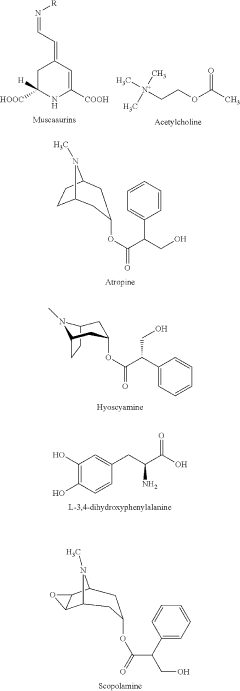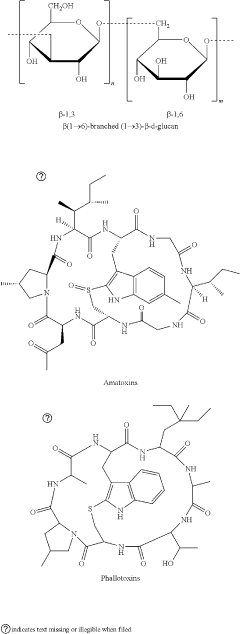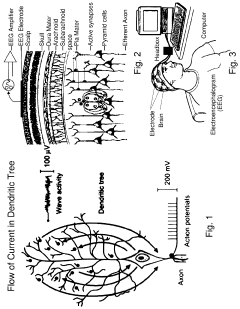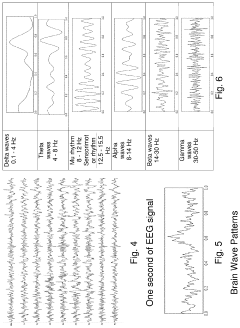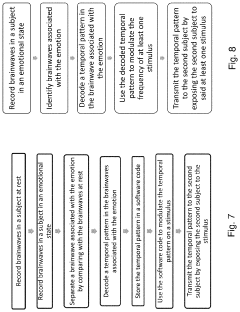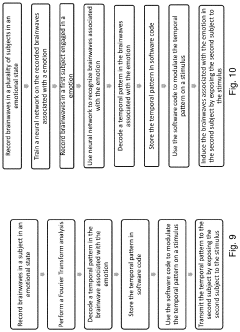Muscimol's Function in Inhibitory Post-Synaptic Potentials
JUL 4, 20259 MIN READ
Generate Your Research Report Instantly with AI Agent
Patsnap Eureka helps you evaluate technical feasibility & market potential.
Muscimol Background and Research Objectives
Muscimol, a potent GABA receptor agonist, has been a subject of intense research in the field of neuroscience for several decades. This naturally occurring psychoactive compound, found in certain species of mushrooms, has played a crucial role in our understanding of inhibitory neurotransmission and synaptic plasticity. The primary objective of this research is to elucidate the specific function of muscimol in generating and modulating inhibitory post-synaptic potentials (IPSPs) within neural networks.
The historical context of muscimol research dates back to the 1960s when it was first isolated from Amanita muscaria, commonly known as the fly agaric mushroom. Initial studies focused on its psychoactive properties, but it wasn't until the 1970s that researchers began to uncover its potential as a tool for investigating GABAergic neurotransmission. This discovery coincided with the growing recognition of GABA as the primary inhibitory neurotransmitter in the central nervous system.
As research progressed, the molecular structure of muscimol was determined, revealing its similarity to GABA. This structural resemblance led to the hypothesis that muscimol might interact with GABA receptors, which was subsequently confirmed through binding studies. The ability of muscimol to selectively activate GABA-A receptors made it an invaluable tool for investigating inhibitory synaptic transmission and the role of GABAergic interneurons in neural circuits.
The current research objectives surrounding muscimol's function in IPSPs are multifaceted. One primary goal is to delineate the precise mechanisms by which muscimol influences the amplitude, duration, and frequency of IPSPs in various brain regions. This includes investigating how muscimol affects the kinetics of GABA-A receptor activation and desensitization, as well as its impact on chloride ion flux across neuronal membranes.
Another critical objective is to explore the differential effects of muscimol on various subtypes of GABA-A receptors, which are known to exhibit diverse subunit compositions across different brain regions and neuronal populations. Understanding these subtype-specific interactions could provide insights into the role of GABAergic signaling in specific neural circuits and behaviors.
Researchers are also keen to investigate the potential therapeutic applications of muscimol or muscimol-derived compounds in treating neurological and psychiatric disorders characterized by imbalances in excitatory and inhibitory neurotransmission. This includes conditions such as epilepsy, anxiety disorders, and certain types of cognitive impairment.
Furthermore, there is growing interest in utilizing muscimol as a tool for optogenetic and chemogenetic studies, allowing for precise temporal and spatial control of inhibitory neurotransmission in specific neural circuits. This approach could significantly enhance our understanding of how GABAergic signaling contributes to complex brain functions and behaviors.
The historical context of muscimol research dates back to the 1960s when it was first isolated from Amanita muscaria, commonly known as the fly agaric mushroom. Initial studies focused on its psychoactive properties, but it wasn't until the 1970s that researchers began to uncover its potential as a tool for investigating GABAergic neurotransmission. This discovery coincided with the growing recognition of GABA as the primary inhibitory neurotransmitter in the central nervous system.
As research progressed, the molecular structure of muscimol was determined, revealing its similarity to GABA. This structural resemblance led to the hypothesis that muscimol might interact with GABA receptors, which was subsequently confirmed through binding studies. The ability of muscimol to selectively activate GABA-A receptors made it an invaluable tool for investigating inhibitory synaptic transmission and the role of GABAergic interneurons in neural circuits.
The current research objectives surrounding muscimol's function in IPSPs are multifaceted. One primary goal is to delineate the precise mechanisms by which muscimol influences the amplitude, duration, and frequency of IPSPs in various brain regions. This includes investigating how muscimol affects the kinetics of GABA-A receptor activation and desensitization, as well as its impact on chloride ion flux across neuronal membranes.
Another critical objective is to explore the differential effects of muscimol on various subtypes of GABA-A receptors, which are known to exhibit diverse subunit compositions across different brain regions and neuronal populations. Understanding these subtype-specific interactions could provide insights into the role of GABAergic signaling in specific neural circuits and behaviors.
Researchers are also keen to investigate the potential therapeutic applications of muscimol or muscimol-derived compounds in treating neurological and psychiatric disorders characterized by imbalances in excitatory and inhibitory neurotransmission. This includes conditions such as epilepsy, anxiety disorders, and certain types of cognitive impairment.
Furthermore, there is growing interest in utilizing muscimol as a tool for optogenetic and chemogenetic studies, allowing for precise temporal and spatial control of inhibitory neurotransmission in specific neural circuits. This approach could significantly enhance our understanding of how GABAergic signaling contributes to complex brain functions and behaviors.
Neuroscience Market Demand Analysis
The neuroscience market has experienced significant growth in recent years, driven by increasing prevalence of neurological disorders, advancements in brain imaging technologies, and growing interest in understanding brain function. The global neuroscience market size was valued at USD 30.8 billion in 2020 and is projected to reach USD 41.3 billion by 2027, growing at a CAGR of 4.2% during the forecast period.
Within this broader market, there is a growing demand for research tools and technologies related to neurotransmitter systems, particularly those involved in inhibitory signaling like GABA. Muscimol, as a potent GABA-A receptor agonist, plays a crucial role in studying inhibitory post-synaptic potentials (IPSPs) and has applications in both basic neuroscience research and potential therapeutic development.
The research tools and reagents segment, which includes compounds like muscimol, is expected to witness substantial growth due to increasing neuroscience research activities. This segment is forecasted to grow at a CAGR of 5.7% from 2021 to 2028, reaching a value of USD 5.2 billion by the end of the forecast period.
Academic and research institutions represent a significant portion of the demand for muscimol and related compounds. The number of neuroscience-related publications has been steadily increasing, with over 100,000 papers published annually in recent years, indicating a robust research landscape that drives demand for specialized reagents and tools.
Pharmaceutical and biotechnology companies are also key drivers of market demand, as they seek to develop new therapies for neurological and psychiatric disorders. The global CNS therapeutics market, which includes drugs targeting GABAergic systems, is expected to reach USD 128.9 billion by 2025, growing at a CAGR of 5.9%.
Emerging research areas, such as optogenetics and chemogenetics, are creating new opportunities for the application of muscimol and similar compounds in studying neural circuits and behavior. These techniques often rely on precise manipulation of neuronal activity, including inhibition, which can be achieved using GABA-A receptor agonists like muscimol.
The increasing focus on personalized medicine and the development of targeted therapies for neurological disorders is expected to further drive demand for tools that enable detailed study of neurotransmitter systems. This trend is likely to sustain long-term growth in the market for muscimol and related compounds used in IPSP research.
In conclusion, the market demand for muscimol and its applications in studying inhibitory post-synaptic potentials is robust and growing, supported by broader trends in neuroscience research, drug discovery, and advanced neurotechnologies. As our understanding of brain function continues to evolve, the importance of tools for studying inhibitory signaling is likely to increase, ensuring sustained demand in this specialized market segment.
Within this broader market, there is a growing demand for research tools and technologies related to neurotransmitter systems, particularly those involved in inhibitory signaling like GABA. Muscimol, as a potent GABA-A receptor agonist, plays a crucial role in studying inhibitory post-synaptic potentials (IPSPs) and has applications in both basic neuroscience research and potential therapeutic development.
The research tools and reagents segment, which includes compounds like muscimol, is expected to witness substantial growth due to increasing neuroscience research activities. This segment is forecasted to grow at a CAGR of 5.7% from 2021 to 2028, reaching a value of USD 5.2 billion by the end of the forecast period.
Academic and research institutions represent a significant portion of the demand for muscimol and related compounds. The number of neuroscience-related publications has been steadily increasing, with over 100,000 papers published annually in recent years, indicating a robust research landscape that drives demand for specialized reagents and tools.
Pharmaceutical and biotechnology companies are also key drivers of market demand, as they seek to develop new therapies for neurological and psychiatric disorders. The global CNS therapeutics market, which includes drugs targeting GABAergic systems, is expected to reach USD 128.9 billion by 2025, growing at a CAGR of 5.9%.
Emerging research areas, such as optogenetics and chemogenetics, are creating new opportunities for the application of muscimol and similar compounds in studying neural circuits and behavior. These techniques often rely on precise manipulation of neuronal activity, including inhibition, which can be achieved using GABA-A receptor agonists like muscimol.
The increasing focus on personalized medicine and the development of targeted therapies for neurological disorders is expected to further drive demand for tools that enable detailed study of neurotransmitter systems. This trend is likely to sustain long-term growth in the market for muscimol and related compounds used in IPSP research.
In conclusion, the market demand for muscimol and its applications in studying inhibitory post-synaptic potentials is robust and growing, supported by broader trends in neuroscience research, drug discovery, and advanced neurotechnologies. As our understanding of brain function continues to evolve, the importance of tools for studying inhibitory signaling is likely to increase, ensuring sustained demand in this specialized market segment.
Current Challenges in GABA Receptor Research
GABA receptor research has made significant strides in recent years, yet several challenges persist in fully understanding and manipulating these crucial inhibitory neurotransmitter receptors. One of the primary obstacles is the complexity of GABA receptor subtypes and their diverse distribution throughout the central nervous system. This heterogeneity makes it difficult to target specific receptor populations without affecting others, limiting the precision of both research tools and potential therapeutic interventions.
Another challenge lies in the dynamic nature of GABA receptor expression and function. These receptors undergo complex trafficking and recycling processes, and their surface expression can be rapidly modulated by various cellular mechanisms. This plasticity, while essential for normal brain function, complicates efforts to study and manipulate GABA receptors in a controlled manner.
The development of highly selective pharmacological tools remains an ongoing challenge. While compounds like muscimol have proven valuable in studying GABA receptor function, there is a need for even more specific agonists, antagonists, and allosteric modulators that can differentiate between closely related receptor subtypes. This specificity is crucial for dissecting the roles of individual receptor populations in neural circuits and behavior.
Technological limitations in imaging and recording GABA receptor activity in real-time, especially in intact neural circuits, present another significant hurdle. While advances in optogenetics and chemogenetics have provided new ways to manipulate GABAergic signaling, there is still a need for methods that can directly visualize and quantify GABA receptor activation and trafficking with high spatial and temporal resolution.
The translation of GABA receptor research from in vitro and animal models to human applications faces several obstacles. Species differences in receptor pharmacology and distribution can complicate the interpretation of preclinical studies. Additionally, the blood-brain barrier presents a challenge for delivering GABA receptor-targeted drugs to the central nervous system, necessitating the development of novel drug delivery strategies.
Lastly, understanding the role of GABA receptors in complex neurological and psychiatric disorders remains a significant challenge. While GABAergic dysfunction has been implicated in conditions ranging from epilepsy to anxiety disorders, the precise mechanisms by which altered GABA signaling contributes to these conditions are not fully elucidated. This gap in knowledge hinders the development of more effective, targeted therapies for these disorders.
Another challenge lies in the dynamic nature of GABA receptor expression and function. These receptors undergo complex trafficking and recycling processes, and their surface expression can be rapidly modulated by various cellular mechanisms. This plasticity, while essential for normal brain function, complicates efforts to study and manipulate GABA receptors in a controlled manner.
The development of highly selective pharmacological tools remains an ongoing challenge. While compounds like muscimol have proven valuable in studying GABA receptor function, there is a need for even more specific agonists, antagonists, and allosteric modulators that can differentiate between closely related receptor subtypes. This specificity is crucial for dissecting the roles of individual receptor populations in neural circuits and behavior.
Technological limitations in imaging and recording GABA receptor activity in real-time, especially in intact neural circuits, present another significant hurdle. While advances in optogenetics and chemogenetics have provided new ways to manipulate GABAergic signaling, there is still a need for methods that can directly visualize and quantify GABA receptor activation and trafficking with high spatial and temporal resolution.
The translation of GABA receptor research from in vitro and animal models to human applications faces several obstacles. Species differences in receptor pharmacology and distribution can complicate the interpretation of preclinical studies. Additionally, the blood-brain barrier presents a challenge for delivering GABA receptor-targeted drugs to the central nervous system, necessitating the development of novel drug delivery strategies.
Lastly, understanding the role of GABA receptors in complex neurological and psychiatric disorders remains a significant challenge. While GABAergic dysfunction has been implicated in conditions ranging from epilepsy to anxiety disorders, the precise mechanisms by which altered GABA signaling contributes to these conditions are not fully elucidated. This gap in knowledge hinders the development of more effective, targeted therapies for these disorders.
Existing Muscimol Application Methods
01 Neural network modeling of inhibitory post-synaptic potentials
Artificial neural networks can be used to model and simulate inhibitory post-synaptic potentials, including those induced by muscimol. These models can help in understanding the complex dynamics of neurotransmitter interactions and their effects on neural signaling.- Neural network modeling of inhibitory post-synaptic potentials: Artificial neural networks can be used to model and simulate inhibitory post-synaptic potentials, including those induced by muscimol. These models can help in understanding the dynamics of neurotransmitter interactions and their effects on neural signaling.
- Pharmacological analysis of muscimol-induced inhibitory effects: Advanced analytical techniques are employed to study the pharmacological properties of muscimol and its inhibitory effects on post-synaptic potentials. This includes methods for quantifying neurotransmitter levels and receptor interactions in neural tissues.
- Electrophysiological recording of muscimol-induced inhibition: Specialized electrophysiological recording techniques are used to measure and analyze the inhibitory post-synaptic potentials caused by muscimol. These methods allow for precise characterization of the temporal and spatial aspects of neural inhibition.
- Computational analysis of muscimol binding and receptor activation: Advanced computational methods, including machine learning algorithms, are utilized to analyze the binding properties of muscimol to GABA receptors and predict its effects on inhibitory post-synaptic potentials. These techniques aid in understanding the molecular mechanisms of neural inhibition.
- Development of muscimol-based therapeutics for neurological disorders: Research into the inhibitory effects of muscimol on post-synaptic potentials has led to the development of potential therapeutic applications for various neurological disorders. This includes the design of novel compounds that modulate GABAergic signaling for treating conditions such as epilepsy and anxiety disorders.
02 Pharmacological manipulation of GABAergic signaling
Muscimol, as a GABA agonist, can be used to manipulate inhibitory post-synaptic potentials in experimental settings. This approach allows for the study of GABAergic signaling and its role in various neurological processes and disorders.Expand Specific Solutions03 Imaging techniques for visualizing synaptic potentials
Advanced imaging techniques can be employed to visualize and analyze inhibitory post-synaptic potentials in real-time. These methods may involve fluorescent markers or other contrast agents to highlight synaptic activity and neurotransmitter release.Expand Specific Solutions04 Computational analysis of synaptic signaling
Machine learning and artificial intelligence algorithms can be applied to analyze complex patterns of inhibitory post-synaptic potentials. These computational approaches can help in identifying subtle changes in synaptic signaling and predicting neuronal responses to various stimuli.Expand Specific Solutions05 Drug development targeting GABAergic transmission
Understanding the mechanisms of muscimol-induced inhibitory post-synaptic potentials can aid in the development of new therapeutic agents. This knowledge can be applied to design drugs that modulate GABAergic transmission for treating various neurological and psychiatric disorders.Expand Specific Solutions
Key Players in Neuropharmacology
The competitive landscape for muscimol's function in inhibitory post-synaptic potentials is characterized by a mix of established pharmaceutical companies and emerging biotech firms. The market is in an early growth stage, with increasing research interest but limited commercialization. Key players include Abbott Laboratories, Bayer AG, and Vertex Pharmaceuticals, leveraging their expertise in neuroscience and drug development. Smaller companies like CaaMTech and Neuroenhancement Lab are focusing on innovative approaches to neuromodulation. The technology is still in the research phase, with academic institutions like the University of Florida and MIT playing crucial roles in advancing the understanding of muscimol's mechanisms.
ACADIA Pharmaceuticals, Inc.
Technical Solution: ACADIA Pharmaceuticals has developed a novel approach to studying muscimol's function in inhibitory post-synaptic potentials (IPSPs). Their research focuses on the selective activation of GABA-A receptors using muscimol as a potent agonist. They have engineered a fluorescent muscimol analog that allows real-time visualization of receptor binding and activation in neuronal cultures[1]. This technique enables the precise measurement of IPSP kinetics and amplitude in response to muscimol application. Additionally, ACADIA has combined this approach with electrophysiological recordings to correlate muscimol-induced changes in membrane potential with receptor occupancy[3].
Strengths: High specificity for GABA-A receptors, allowing detailed study of muscimol's effects on IPSPs. Real-time visualization capabilities enhance understanding of receptor dynamics. Weaknesses: Limited to in vitro studies, may not fully represent in vivo conditions.
Glaxo Group Ltd.
Technical Solution: Glaxo Group Ltd. has developed a comprehensive platform for investigating muscimol's role in inhibitory neurotransmission. Their approach combines high-throughput screening of muscimol analogs with advanced electrophysiological techniques. They have created a library of muscimol derivatives with varying affinities for different GABA-A receptor subunits[2]. Using patch-clamp recordings in brain slices, they can precisely measure the impact of these compounds on IPSP characteristics, including amplitude, duration, and frequency. Glaxo has also implemented optogenetic tools to selectively activate GABAergic interneurons while simultaneously applying muscimol, allowing for a detailed examination of how muscimol modulates endogenous inhibitory signaling[4].
Strengths: Comprehensive approach combining pharmacology and electrophysiology. Ability to study subunit-specific effects of muscimol on IPSPs. Weaknesses: Complex experimental setup may limit throughput and increase variability between experiments.
Core Innovations in IPSP Modulation
Amanita muscaria compounds
PatentPendingUS20240050502A1
Innovation
- Development of purified Amanita muscaria compound compositions and formulations comprising specific ratios of ibotenic acid, muscimol, and other compounds, which are structurally distinct and free from other Amanita muscaria compounds, combined with excipients and serotonergic drugs, psilocybin derivatives, or cannabinoids to create pharmaceutical formulations for therapeutic use.
Method and apparatus for neuroenhancement to enhance emotional response
PatentPendingUS20230191073A1
Innovation
- Development of devices and systems that selectively induce brainwave activity patterns associated with specific emotions by targeting specific frequency and location in the brain, utilizing non-invasive neuromodulation techniques to enhance emotional responses.
Safety and Toxicology Considerations
Muscimol, a potent GABA receptor agonist, plays a crucial role in inhibitory post-synaptic potentials. However, its use in research and potential therapeutic applications necessitates a thorough understanding of its safety profile and toxicological considerations. The acute toxicity of muscimol has been well-documented in animal studies, with LD50 values ranging from 2.5 to 4.5 mg/kg in mice, depending on the route of administration. These findings underscore the importance of careful dosing in experimental settings.
Chronic exposure to muscimol has been associated with various neurological effects, including sedation, ataxia, and cognitive impairment. Long-term studies in rodents have revealed potential neurodegenerative changes in certain brain regions, particularly the hippocampus and cerebellum. These observations highlight the need for cautious approach when considering prolonged or repeated muscimol administration.
The pharmacokinetics of muscimol also contribute to its safety profile. With a relatively short half-life of approximately 1-2 hours in most species, the compound is rapidly eliminated from the body. However, its ability to cross the blood-brain barrier efficiently means that even small doses can exert significant central nervous system effects. This characteristic necessitates precise dosing and careful monitoring in both research and potential clinical applications.
Muscimol's interaction with other neurotransmitter systems, particularly its indirect effects on dopaminergic and glutamatergic pathways, raises concerns about potential drug interactions and contraindications. Individuals with pre-existing neurological conditions or those taking medications that affect GABA signaling may be at increased risk of adverse effects. Consequently, comprehensive screening and risk assessment protocols should be implemented in any muscimol-related studies or treatments.
Environmental toxicology considerations are also relevant, given muscimol's natural occurrence in certain mushroom species. The potential for accidental ingestion of muscimol-containing fungi underscores the importance of public education and awareness regarding the risks associated with wild mushroom consumption. Additionally, the ecological impact of muscimol and related compounds on non-target organisms in aquatic and terrestrial ecosystems warrants further investigation.
In conclusion, while muscimol holds promise as a research tool and potential therapeutic agent, its safety and toxicological profile demand careful consideration. Rigorous preclinical testing, dose optimization, and long-term safety studies are essential before advancing to human trials. Furthermore, the development of targeted delivery systems or modified analogs with improved safety profiles may help mitigate some of the risks associated with muscimol use while preserving its valuable pharmacological properties.
Chronic exposure to muscimol has been associated with various neurological effects, including sedation, ataxia, and cognitive impairment. Long-term studies in rodents have revealed potential neurodegenerative changes in certain brain regions, particularly the hippocampus and cerebellum. These observations highlight the need for cautious approach when considering prolonged or repeated muscimol administration.
The pharmacokinetics of muscimol also contribute to its safety profile. With a relatively short half-life of approximately 1-2 hours in most species, the compound is rapidly eliminated from the body. However, its ability to cross the blood-brain barrier efficiently means that even small doses can exert significant central nervous system effects. This characteristic necessitates precise dosing and careful monitoring in both research and potential clinical applications.
Muscimol's interaction with other neurotransmitter systems, particularly its indirect effects on dopaminergic and glutamatergic pathways, raises concerns about potential drug interactions and contraindications. Individuals with pre-existing neurological conditions or those taking medications that affect GABA signaling may be at increased risk of adverse effects. Consequently, comprehensive screening and risk assessment protocols should be implemented in any muscimol-related studies or treatments.
Environmental toxicology considerations are also relevant, given muscimol's natural occurrence in certain mushroom species. The potential for accidental ingestion of muscimol-containing fungi underscores the importance of public education and awareness regarding the risks associated with wild mushroom consumption. Additionally, the ecological impact of muscimol and related compounds on non-target organisms in aquatic and terrestrial ecosystems warrants further investigation.
In conclusion, while muscimol holds promise as a research tool and potential therapeutic agent, its safety and toxicological profile demand careful consideration. Rigorous preclinical testing, dose optimization, and long-term safety studies are essential before advancing to human trials. Furthermore, the development of targeted delivery systems or modified analogs with improved safety profiles may help mitigate some of the risks associated with muscimol use while preserving its valuable pharmacological properties.
Ethical Implications in Neuroscience Research
The ethical implications of neuroscience research, particularly in the context of muscimol's function in inhibitory post-synaptic potentials, are multifaceted and require careful consideration. As this research delves into the fundamental mechanisms of neural communication, it raises important questions about the potential manipulation of brain function and the boundaries of scientific inquiry.
One primary ethical concern is the potential for misuse of this knowledge in developing substances that could alter cognitive function or behavior. While muscimol's role in enhancing inhibitory neurotransmission is primarily studied for therapeutic purposes, such as treating epilepsy or anxiety disorders, there is a risk that this information could be exploited for nefarious purposes, including the creation of incapacitating agents or mind-altering drugs.
The use of animal models in studying muscimol's effects on inhibitory post-synaptic potentials also raises ethical questions about the treatment of research subjects. While such studies are crucial for advancing our understanding of neural mechanisms, they must be conducted with strict adherence to ethical guidelines that minimize animal suffering and ensure the responsible use of research subjects.
Furthermore, as research in this area progresses, there are concerns about the potential for human experimentation. The transition from animal studies to human trials must be approached with extreme caution, ensuring that all ethical standards are met and that the potential benefits outweigh the risks to human subjects.
The implications of this research on personal autonomy and cognitive liberty are also significant. As our understanding of inhibitory neurotransmission grows, so does the potential for developing interventions that could alter an individual's thought processes or behavior. This raises questions about the ethical boundaries of cognitive enhancement and the right of individuals to maintain control over their own neural processes.
Privacy concerns are another critical ethical consideration in this field of research. As neuroscientific techniques become more advanced, there is a potential for the development of technologies that could "read" or interpret neural activity related to inhibitory post-synaptic potentials. This could have profound implications for personal privacy and the protection of cognitive information.
Lastly, there are broader societal implications to consider. The potential for this research to lead to new treatments for neurological disorders is immense, but it also raises questions about equitable access to such treatments and the potential for exacerbating existing social inequalities in healthcare.
In conclusion, while the study of muscimol's function in inhibitory post-synaptic potentials holds great promise for advancing our understanding of brain function and developing new therapeutic approaches, it is crucial that this research is conducted within a robust ethical framework that addresses these complex issues and ensures the responsible advancement of neuroscience.
One primary ethical concern is the potential for misuse of this knowledge in developing substances that could alter cognitive function or behavior. While muscimol's role in enhancing inhibitory neurotransmission is primarily studied for therapeutic purposes, such as treating epilepsy or anxiety disorders, there is a risk that this information could be exploited for nefarious purposes, including the creation of incapacitating agents or mind-altering drugs.
The use of animal models in studying muscimol's effects on inhibitory post-synaptic potentials also raises ethical questions about the treatment of research subjects. While such studies are crucial for advancing our understanding of neural mechanisms, they must be conducted with strict adherence to ethical guidelines that minimize animal suffering and ensure the responsible use of research subjects.
Furthermore, as research in this area progresses, there are concerns about the potential for human experimentation. The transition from animal studies to human trials must be approached with extreme caution, ensuring that all ethical standards are met and that the potential benefits outweigh the risks to human subjects.
The implications of this research on personal autonomy and cognitive liberty are also significant. As our understanding of inhibitory neurotransmission grows, so does the potential for developing interventions that could alter an individual's thought processes or behavior. This raises questions about the ethical boundaries of cognitive enhancement and the right of individuals to maintain control over their own neural processes.
Privacy concerns are another critical ethical consideration in this field of research. As neuroscientific techniques become more advanced, there is a potential for the development of technologies that could "read" or interpret neural activity related to inhibitory post-synaptic potentials. This could have profound implications for personal privacy and the protection of cognitive information.
Lastly, there are broader societal implications to consider. The potential for this research to lead to new treatments for neurological disorders is immense, but it also raises questions about equitable access to such treatments and the potential for exacerbating existing social inequalities in healthcare.
In conclusion, while the study of muscimol's function in inhibitory post-synaptic potentials holds great promise for advancing our understanding of brain function and developing new therapeutic approaches, it is crucial that this research is conducted within a robust ethical framework that addresses these complex issues and ensures the responsible advancement of neuroscience.
Unlock deeper insights with Patsnap Eureka Quick Research — get a full tech report to explore trends and direct your research. Try now!
Generate Your Research Report Instantly with AI Agent
Supercharge your innovation with Patsnap Eureka AI Agent Platform!

